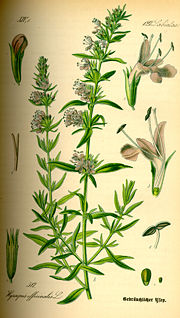Hyssop
- Hyssopus can also refer to a genus of Hymenopteran insects of the family Eulophidae.
- For the biblical plant usually translated as hyssop, see Ezob.
| Hyssop | ||||||||||||
|---|---|---|---|---|---|---|---|---|---|---|---|---|
 Herb Hyssop Hyssopus officinalis
|
||||||||||||
| Scientific classification | ||||||||||||
|
||||||||||||
| Species | ||||||||||||
|
See text |
Hyssop (Hyssopus) is a genus of about 10-12 species of herbaceous or semi-woody plants in the family Lamiaceae, native from the east Mediterranean to central Asia[1]. They are aromatic, with erect branched stems up to 60 cm long covered with fine hairs at the tips. The leaves are narrow oblong, 2-5 cm long. The small blue flowers are borne on the upper part of the branches during summer. By far the best-known species is the Herb Hyssop (H. officinalis), widely cultivated outside its native area in the Mediterranean.
- Species
|
Contents |
Cultivation
The name 'hyssop' can be traced back almost unchanged through the Greek hyssopos and Hebrew esob[1]. In the New Testament, a sponge soaked in sour wine or vinegar was stuck on a branch of hyssop and offered to Jesus of Nazareth on the cross just before he died[2]. Both Matthew and Mark mention the occasion but refer to the plant using the general term "kalamos", which is translated as "reed" or "stick". The Book of Exodus records that the blood of the sacrifices was applied to the doorposts using hyssop on the night of Passover. Its purgative properties are also mentioned in the Book of Psalms. [3]
The seeds are sown in spring and the seedlings planted out 40-50 cm apart. Hyssop can also be propagated from heel cuttings or root division in spring or autumn. Hyssop should be grown in full sun on well drained soil, and will benefit from occasional clipping. It is short-lived, and the plants will need to be replaced every few years. Ideal for use as a low hedge or border within the herb garden.
Hyssop also has uses in the garden, it is said to be a good companion plant to cabbage, partly because it will lure away the Cabbage White butterfly[4]. It has also "been found to improve the yield from grapevines if planted along the rows, particularly if the terrain is rocky or sandy, and the soil is not as easy to work as it might be"[5]. Hyssop is said to be antagonistic to radishes, and they should not be grown nearby. Hyssop also attracts bees, hoverflies and butterflies, thus has a place in the wild garden as well as being useful in controlling pests and encouraging pollination without the use of unnatural methods.
Hyssop leaves can be preserved by drying[1]. They should be harvested on a dry day at the peak of their maturity and the concentration of active ingredients is highest. They should be dried quickly, away from bright sunlight in order to preserve their aromatic ingredients and prevent oxidation of other chemicals. Good air circulation is required, such as an airing cupboard with the door left open, or a sunny room, aiming for a temperature of 20-32°C. Hyssop leaves should dry out in about six days, any longer and they will begin to discolour and lose their flavour[1]. The dried leaves are stored in clean, dry, labelled airtight containers, and will keep for 12-18 months.
Hyssop is used as a food plant by the larvae of some Lepidoptera species including Cabbage Moth.
Usage

Hyssop is used as an ingredient in eau de Cologne and the liqueur Chartreuse. It is also used to color the liquor Absinthe, along with melissa and Roman wormwood.[6] Hyssop is also used, usually in combination with other herbs such as liquorice[7] , in herbal remedies, especially for lung conditions.[8]
Culinary use
Hyssop leaves have a slightly bitter minty flavour and can be added to soups, salads or meats, although should be used sparingly as the flavour is very strong.
See also
- Genus Agastache, commonly known as Giant Hyssop
- Za'atar
References
- ↑ 1.0 1.1 1.2 1.3 "Spotlight on Hyssop" (in English). Retrieved on 2008-09-16.
- ↑ John 19:29
- ↑ Psalms 51:7
- ↑ "Companion Gardening - compatible plants" (in English). Retrieved on 2008-09-15.
- ↑ Hall, Dorothy (1976). The Book of Herbs. Macmillan. ISBN 0330243268.
- ↑ "How Absinthe is Made I - Absinthe Cultivation in Pontarlier" (in English). Retrieved on 2008-09-12.
- ↑ "A history of the therapeutic use of liquorice in Europe" (in English). Retrieved on 2008-09-15.
- ↑ "Herbs > Hyssop (Hyssopus officinalis)" (in English). Retrieved on 2008-09-15.
|
||||||||||||||||||||||||||||||||||||||||||